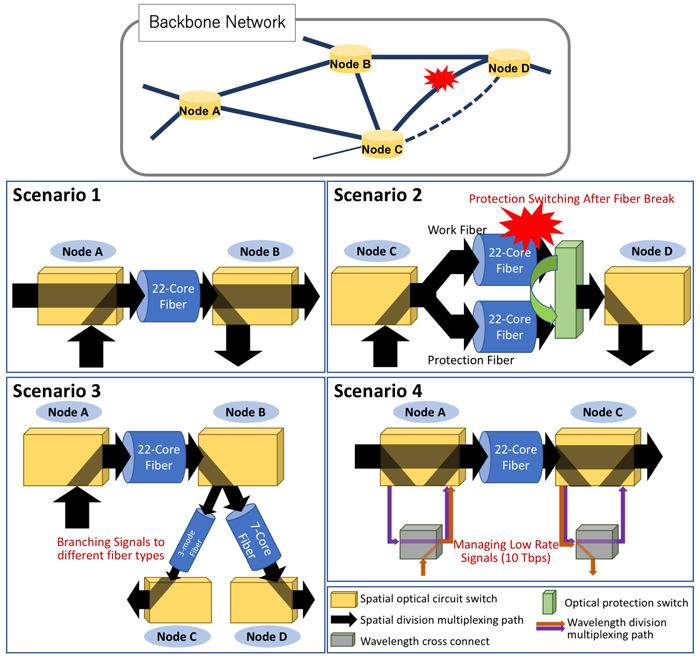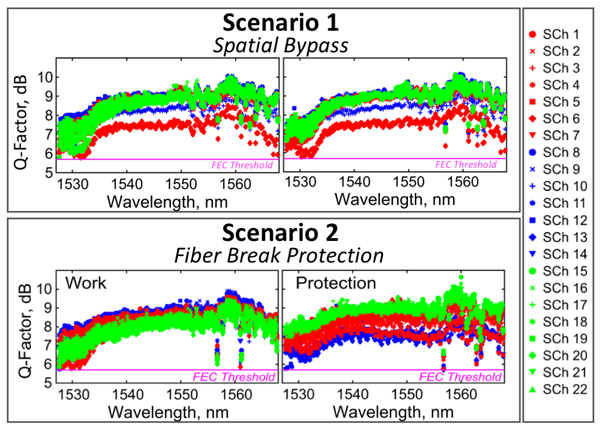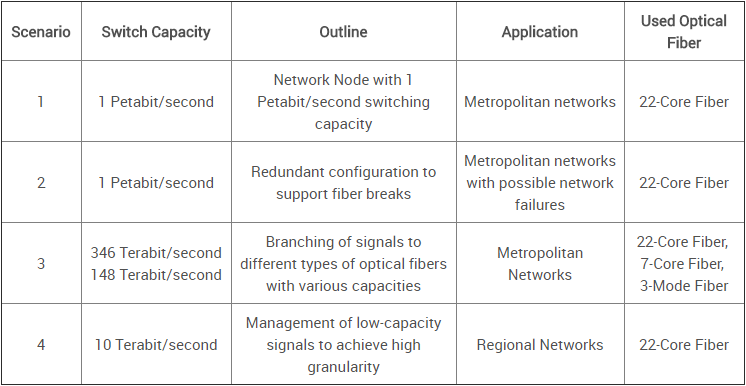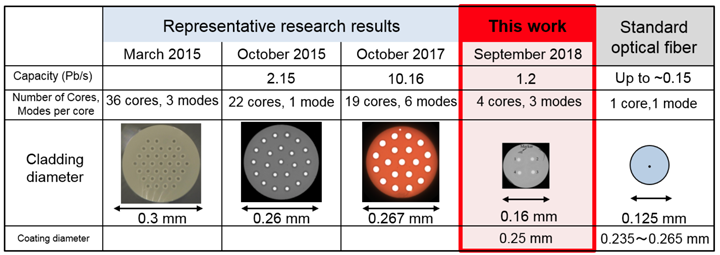
Test stand at NICT // www.nict.go.jp
The Japanese showed the public a network cluster, which is based on 22 fiber optic wires and a MEMS signal controller with a multiplexing system for three-core and seven-core connections, which are now being implemented or are already being used in backbone communication networks and data centers.
The development of Japanese engineers proves that we are able to significantly increase the bandwidth of network connections, not only through an increase in the number of fiber optic cable cores, but also through the improvement of signal switching and routing systems.
As mentioned earlier, the cluster uses a system of 22 fiber optic cores with a multiplex for less “impressive” channels of 3 and 7 optical fibers.

1 Pbit / s is not a monolithic stream. Each core provides a bandwidth of 245 Gbit / s while simultaneously using 202 different wavelengths.

In practice, the researchers achieved an optical cable data transfer rate of 2.15 Pbit / s back in 2015 , but a full-fledged work stand with a similar speed was shown to the public only this fall in Dublin. Then everything rested on routing, as the engineers themselves declare:
To [create a channel] data transmission of a petabite class, new switching technologies are required that will ensure the management and reliable routing of large amounts of data through [topologically] complex networks. To date, such technologies have been unavailable, as existing approaches have been constrained by complexity and / or performance.
The main area of application for their development, the Japanese consider the nodes of communication between data centers and the highway. If now we are able to lay additional cables and increase the throughput of the global network by the volume we need, then there are problems with connecting the equipment.
Due to their computing power, modern server systems are capable of processing colossal data streams, however, the final network interface becomes a bottleneck in this entire design. At the same time, user traffic is growing every year, and the widespread introduction of 5G networks in the next decade will only aggravate the load situation: users will require a larger and larger realtime stream from the same YouTube, which current servers simply can not service due to bandwidth limitations network abilities.
Earlier, a solution to this problem would be to increase the number of servers on the side of data centers with a parallel increase in their density around the world. Now, the development of the Japanese allows you to modify the connection points of equipment to the network, significantly increasing the flow of data from existing racks.
Effective mass use of the Japanese development will require upgrading existing networks, but it can work with low-power networks: the cluster works with three- and seven-core connections, which are now considered the latest generation of low-power trunk fiber optic cables. A cluster can deliver a stream of 148 Tb / s to a three-core cable, and 346 Tb / s to a seven-core cable.

At the same time, the existing cluster not only fully communicates and routes the declared data stream, but also has a structure that meets the requirements of data centers and providers in terms of fault tolerance. For example, the possibility of backup switching and routing bypassing the damaged section of the cluster.
It is important to note that systematic work with fiber has been going on for a long time and researchers are working not only towards the creation of new transmission and routing systems, but also at realizing the potential of already laid optics. So, in November 2018, a report was published that the group achieved a bandwidth of 1.2 Pbit / s on a test bench with a four-wire cable immediately on 386 channels. The table below shows that initially work was carried out with 36-core cables at the same speed.

The research team plans to achieve a speed close to 1 Pbit / s on a standard cable in one core and one mode, which are used when laying user networks. However, the main problem of this development is the high-quality routing of such a data stream. So far, a result ready for practical implementation in data centers has been achieved only on the 22-core cluster, which we talked about above.
It is likely that the development of Japanese scientists will allow us to avoid network collapse, which threatens the widespread adoption of 5G networks, and also someday will increase the speed of user connections within the "last mile" from the existing 100 Mbps to 1 Gbit / s more impressive and comfortable values.